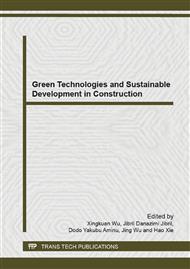[1]
S. J. S. Wansom, Pozzolanic Activity of Industrial Sugar Cane, vol. 17, no. 4, p.349–357, (2010).
Google Scholar
[2]
E. M. R. Fairbairn, B. B. Americano, G. C. Cordeiro, T. P. Paula, R. D. Toledo Filho, and M. M. Silvoso, Cement replacement by sugar cane bagasse ash: CO2 emissions reduction and potential for carbon credits., Journal of environmental management, vol. 91, no. 9, p.1864–71, Sep. (2010).
DOI: 10.1016/j.jenvman.2010.04.008
Google Scholar
[3]
M. H. Zhang, R. Lastra, and V. M. Malhotra, Rice-Husk Ash Paste And Concrete: Some Aspects of Hydration and The Microstructure of The Interfacial Zone Between The Aggregate and Paste, Cement and Concrete Research, vol. 26, no. 6, p.963–977, (1996).
DOI: 10.1016/0008-8846(96)00061-0
Google Scholar
[4]
BS 12-Specifications for Portland Cement, British Standards Institute, London, (1996).
Google Scholar
[5]
522: Part 4 Specification for Portland Cement (Ordinary and Rapid hardening), Malaysian Standards, (1989).
Google Scholar
[6]
BS 1881-125 Testing Concrete: Methods of Mixing and Sampling Fresh Concrete in the Laboratory, British Standards Institute, London, (1986).
Google Scholar
[7]
BS 1881: Part 102 Testing Fresh Concrete: Method for determination of Slump, British Standards Institute, London, (1983).
Google Scholar
[8]
BS 1881: Part 111 Method for Determination of Compressive Strength of Concrete, British Standards Institute, London, (1983).
Google Scholar
[9]
D. D. Bui, J. Hu, and P. Stroeven, Particle size effect on the strength of rice husk ash blended gap-graded Portland cement concrete, Cement and Concrete Composites, vol. 27, no. 3, p.357–366, Mar. (2005).
DOI: 10.1016/j.cemconcomp.2004.05.002
Google Scholar
[10]
H. Bin Mahmud, M. F. A. Malik, R. A. Kahar, M. F. M. Zain, and S. N. Raman, Mechanical Properties and Durability of Normal and Water Reduced High Strength Grade 60 Concrete Containing Rice Husk Ash, Journal of Advanced Concrete Technology, vol. 7, no. 1, p.21–30, (2009).
DOI: 10.3151/jact.7.21
Google Scholar
[11]
N. L. M. Kamal and U. T. Petronas, The Influence Of Burning Temperatures and Percentage Inclusion of Microwave Incinerated Rice Husk Ash ( MIRHA ) On Normal Strength Concrete, no. 47, p.531–538.
Google Scholar


